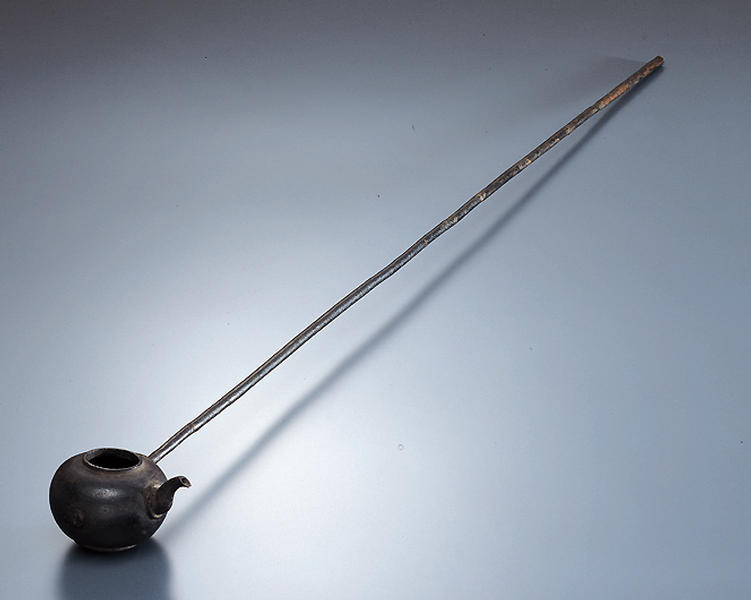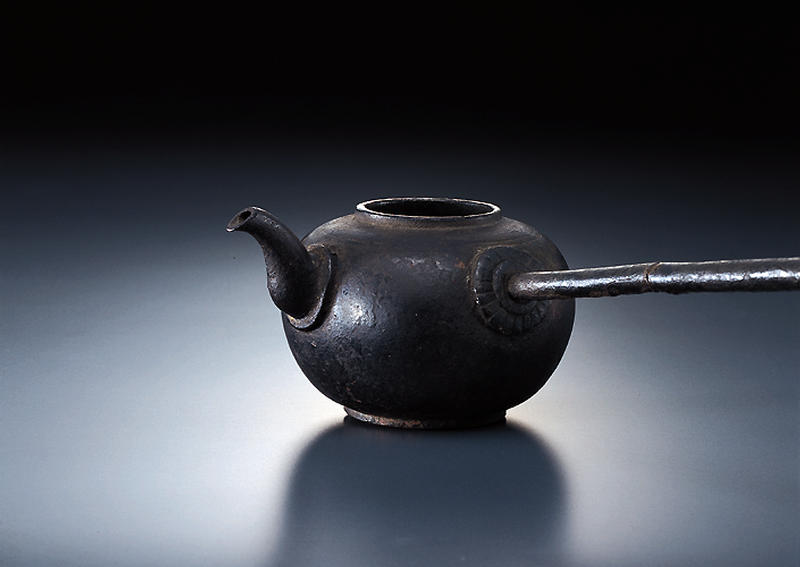金銅香水杓
- 鎌倉時代
- 13c
- 鋳銅製
- H-5 D-9 W-81.5
- 所蔵
- 東大寺二月堂伝来
東大寺
東大寺(とうだいじ)
奈良市雑司町。華厳宗。天平17年(745)聖武天皇の発願により、「金光明経」の護国思想に則って日本各地に設置された国分寺の中心となる総国分寺として創建された。
本尊の留舎那仏(るしゃなぶつ)をおさめる大仏殿は天平勝宝3年(751)に完成。翌年の4月9日に大仏の開眼供養会をおこなった。
治承4年(1180)に平重衡(たいらのしげひら)の焼き討ちによっておおくの堂塔が炎上したが、重源が勧進となり、源頼朝等を檀越として復興。
永禄10年(1567)には三好三人衆、松永久秀の乱によって再び大仏殿が炎上、大仏の首も焼け落ちたが、大仏は山田道安のてによって旧状に復し、元禄5年(1692)に大仏殿も復興した。
正倉院をはじめ、三月堂、転害門などの創建以来の建物をはじめ、奈良、平安、鎌倉時代のあまたの文化財を有する、わが国の文化財の宝庫。世界文化遺産。
伎楽面(迦楼羅)
黒漆鼓胴
お水取り
お水取り
奈良市東大寺二月堂の行事。3月1日から二七日(14日間)行われる修二会(修二月会)のなかの一行法で、3月12日(旧暦の2月12日)に行われる一行法。
深夜、呪師を先頭にした7人の練行衆が二月堂前の井屋の閼伽井戸で閼伽水(香水)を汲み堂に運ぶ。縁起によればこの水は、若狭の遠敷明神が二月堂の神々の勧請の時に遅れ、お詫びとして神の霊水を本尊に捧げられたもので、若狭から地の下を送られてくるという。
修二会は十一面観音に罪や過ちを懺悔する十一面悔過の法要。天平勝宝4年(752)に実忠によって始められたと伝えられる。
二月堂練行衆盤(日の丸盆)
Catalogue Entry
Kamakura period, 13th century (dated 1247)
Cast bronze
Length, 81.5cm; jar height, 5.0cm
A small, wide-mouthed jar made of cast bronze is attached to a long handle to form a ladle, and this ladle would have been used in a temple to scoop up sanctified water. The small jar has a low foot and a flat, rounded torso fitted with a short spout. The long handle pierces the torso of the jar, and its tip is caulked shut. The handle is made of bronze sheeting wrapped around an iron rod and has been formed to look like a length of bamboo.
The side of the jar has a carved inscription which identifies the ladle as a ritual ladle and lists the date of the 5th day of the 2nd month of Kangen 5. Another line of the inscription is not fully decipherable.
The form of this ladle is the same as extant ladles at Todaiji, Nara (4 ladles extant, all designated Important Cultural Properties), and thus this ladle might also be considered to have been originally in that temple's collection. In addition, three of the four ladles at Todaiji are inscribed with dates -- 3rd day of 2nd month Kencho 5, 13th day of 2nd month Kencho 7, a day in the 8th month Bun'ei 4--and the 4th has an inscription identical to the present ladle, 5th day of the 2nd month of Kangen 5.
At Todaiji, these ladles are used as Omizutori to sprinkle sanctified water on pilgrims and parishioners after the "Running Ceremony" of the famous Nigatsudo Shunie. The form of the pre-sent ladle's jar and spout are typical of these ritual utensils from the Kamakura period, and as it is in a particularly fine state of preservation, the present ladle is an extremely important example of one form of ritual utensil used at the Shunie of Todaiji during Japan's medieval period. SS
解説(春の玉手箱)
銅鋳製の広口の小壺に,長い柄をつけた杓で,胴の側面に「寛元五年(一二四七)二月五日…」の紀年銘をもつ。東大寺では,この香水杓を「お水取り」として名高い二月堂修二会の「走りの行法」のあと,参詣者や信者に香水(浄水)をふるまう際に用いる。壺や注口の形に鎌倉時代の特色が顕著であり,しかも保存も良好で,中世の東大寺修二会所用具の一端を示す遺品として大変貴重である。東大寺現存品には,「建長五年二月三日」,「建長七年二月十三日」,「文永四年八月日」の紀年を有する三枝の品のほかに,本品と同じ「寛元五年二月五日」の紀年銘をもつ一枝がある。小壺は注口のカーヴにいたるまで緊張感があり、鉄棒を芯として銅板を巻いた細く美しい柄とのバランスも絶妙である。

